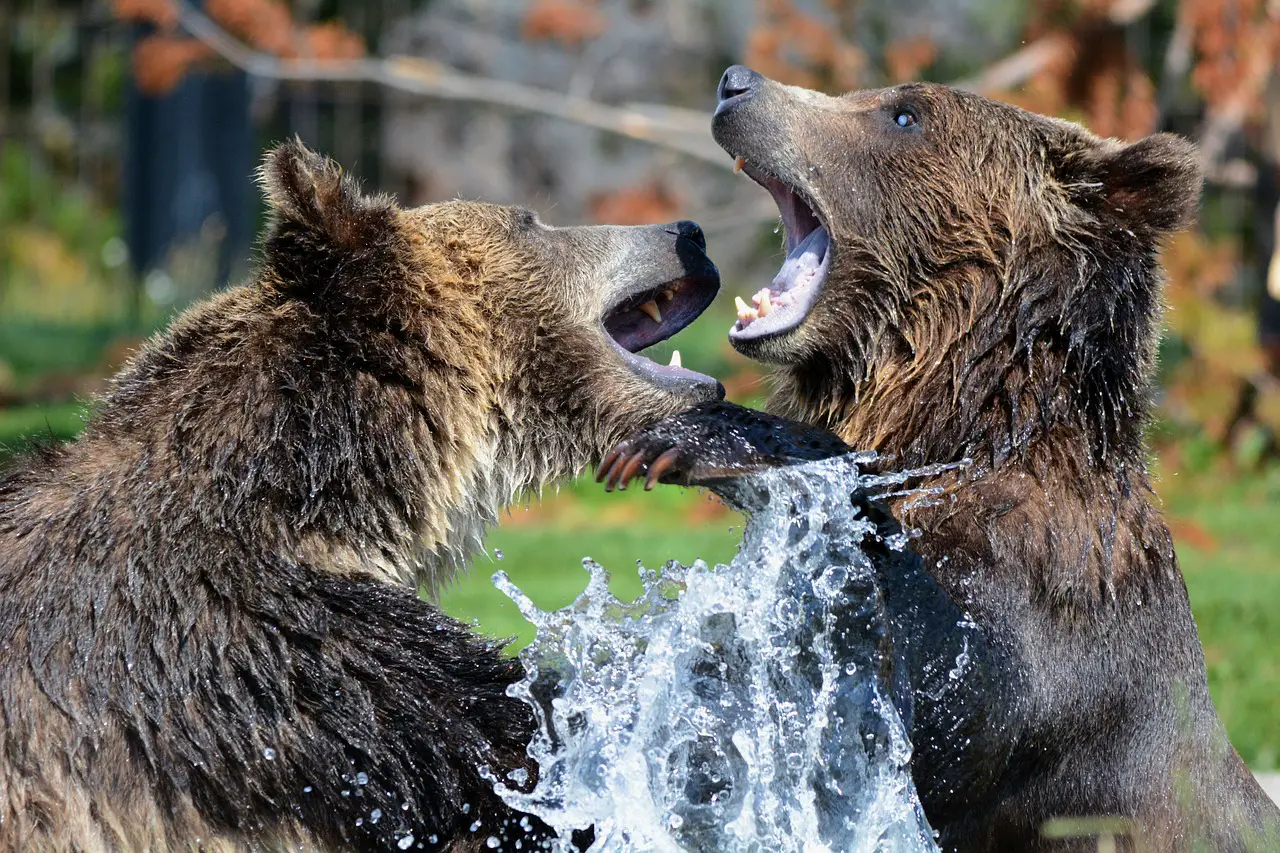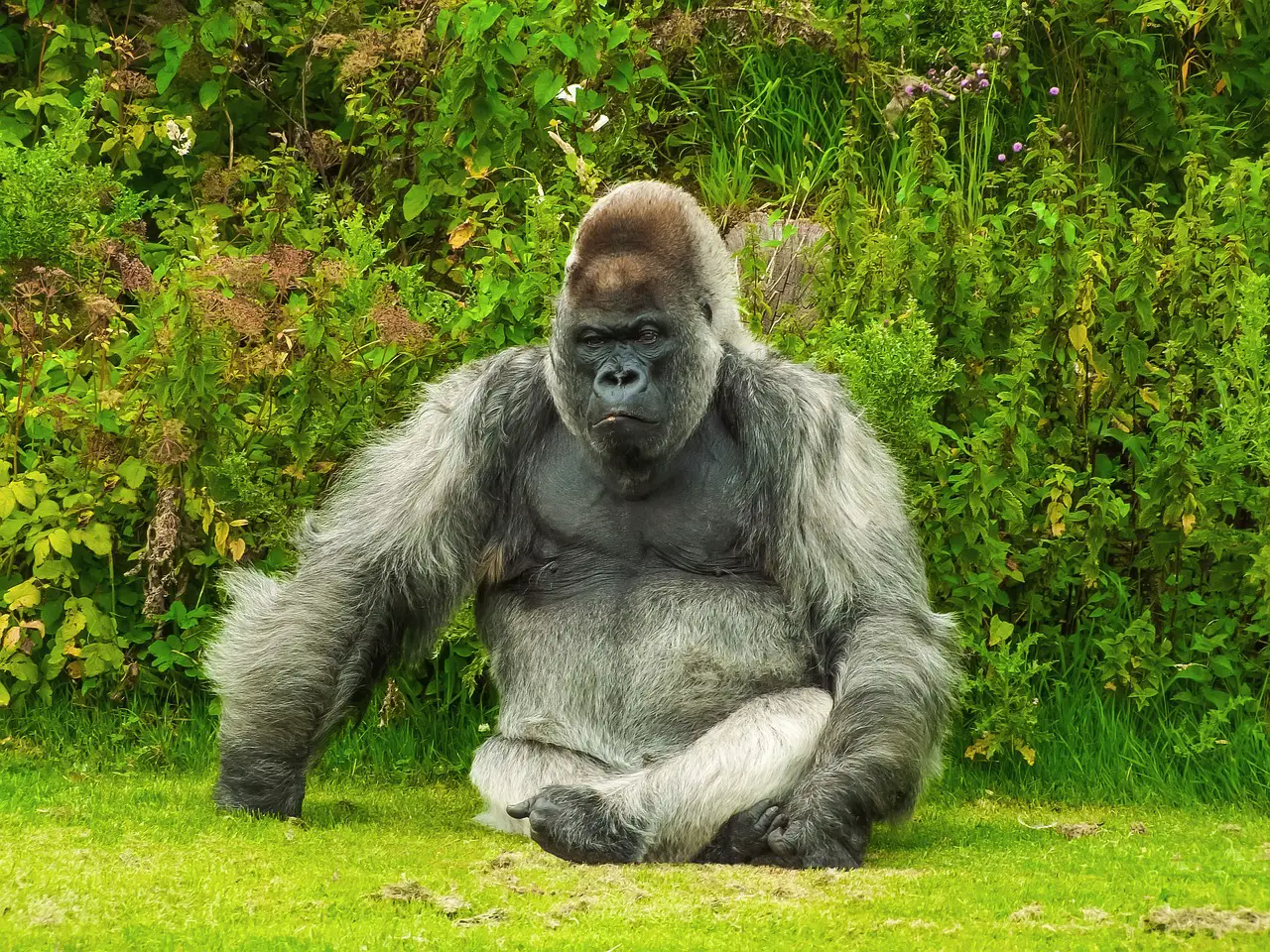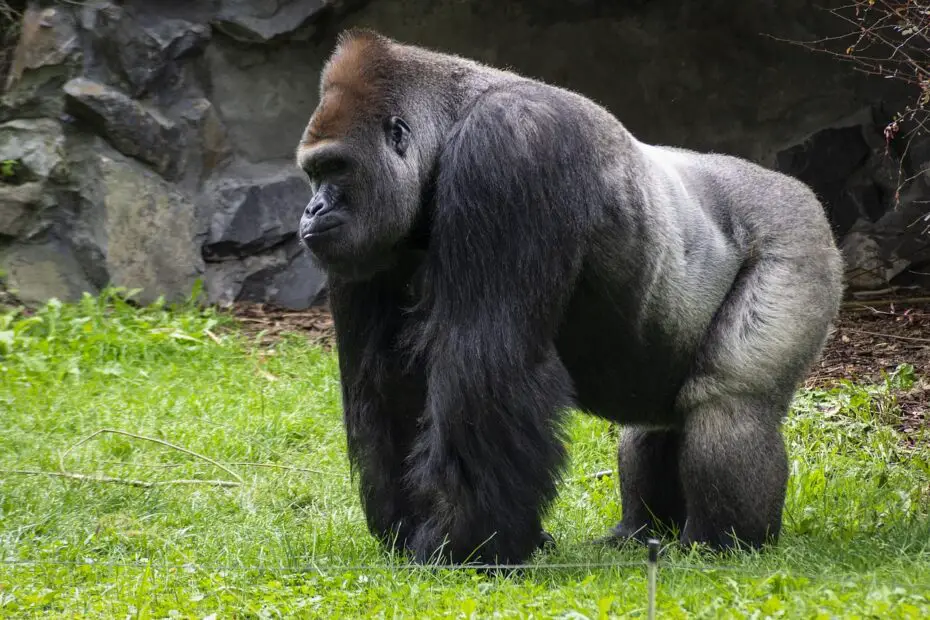Bear vs Gorilla, who is stronger? When it comes to comparing the prowess of the animal kingdom, few debates ignite more fascination than the clash between a bear and a gorilla. These awe-inspiring creatures possess remarkable strength and captivating characteristics, making them natural contenders for discussion.
In this article, we will delve into the distinct qualities of bears and gorillas, exploring their physical attributes, habitat, behavior, diet, predatory skills, communication methods, endangerment status, and interactions with humans. Join us on this thrilling exploration of the bear vs gorilla showdown.
You may also want to read about: grizzly bear vs polar bear.
Bear vs Gorilla: Physical Characteristics
Bears, often associated with their iconic bulk and lumbering gait, possess a robust physique. With a wide range of species, including grizzly bears, polar bears, and black bears, they exhibit variations in size, fur color, and physical adaptations. Typically, bears have strong limbs, sharp claws, and a muscular build that aids them in foraging and defending themselves.
On the other hand, gorillas are the largest living primates, renowned for their impressive size and formidable presence. Their bodies are covered in coarse black hair, and they possess a prominent sagittal crest on the top of their skulls. Gorillas have strong arms, which enable them to climb trees effortlessly, and their large canines serve as intimidating tools during confrontations.
When comparing the physical attributes of bears and gorillas, it becomes evident that both animals are imposing in their own right. However, bears, with their sheer bulk and powerful claws, showcase a more intimidating exterior.

Bear vs Gorilla: Habitat and Distribution
Bears can be found across various habitats, depending on the species. Grizzly bears, for instance, inhabit mountainous regions, while polar bears dwell in the Arctic regions. Black bears, on the other hand, are adaptable and can thrive in a diverse range of environments, including forests, swamps, and even urban areas. Geographically, bears can be found in North America, Europe, Asia, and parts of South America.
Gorillas, on the contrary, are native to the dense forests of Africa. They are divided into two species: the Eastern gorilla and the Western gorilla, each with distinct subspecies. Eastern gorillas reside in the mountainous regions of Central and East Africa, while Western gorillas primarily inhabit the lowland forests and swamps of West Africa. The distribution of gorillas is relatively limited compared to bears.
Bear vs Gorilla: Behavior and Social Structure
Bears are generally solitary animals, preferring their own company over forming social groups. However, they do display social behavior during mating season or when searching for food sources. Mother bears also exhibit strong maternal instincts, nurturing and protecting their cubs until they are ready to venture out on their own.
Gorillas, on the other hand, are highly social creatures, living in cohesive family groups called troops or bands. These groups are led by a dominant silverback male, who is responsible for protecting the members and maintaining order. Gorillas engage in intricate social interactions, including grooming, playing, and vocalizations, which serve as important elements in their tight-knit communities.
When it comes to social behavior, gorillas clearly surpass bears in their ability to form complex and cohesive social structures.
Bear vs Gorilla: Diet and Feeding Habits
Bears exhibit a diverse diet, consuming both plant matter and animal protein. Their food preferences vary depending on the species and their habitat. While some bears are omnivorous and consume a mix of vegetation, fruits, nuts, insects, and fish, others, like the polar bear, have adapted to a primarily carnivorous diet, feasting on seals and other marine mammals. Bears possess strong jaws and sharp teeth, allowing them to process a wide range of food sources.
Gorillas, on the other hand, are herbivores, mainly feeding on a variety of vegetation. They are primarily folivorous, consuming leaves, shoots, and stems, but also incorporate fruits, flowers, and bark into their diet. With their large size and powerful jaws, gorillas can efficiently process tough plant matter, ensuring they meet their nutritional needs.
While bears exhibit a broader dietary spectrum, the specialized herbivorous diet of gorillas is an impressive adaptation in itself.
Predatory Skills and Defense Mechanisms
Bears are skilled predators and have a diverse range of hunting techniques depending on the species and available prey. They can chase down small mammals, fish for salmon, or scavenge carrion when opportunities arise. When it comes to defense, bears rely on their size, strength, and powerful claws. They can stand on their hind legs to appear more intimidating, swipe at attackers with their claws, or use their jaws to deliver powerful bites.
Gorillas, on the other hand, are not known for their predatory skills. Instead, they possess an intimidating presence and formidable strength that serves as a defense mechanism. In confrontations, gorillas resort to displaying aggressive behaviors, such as chest-beating, vocalizing loudly, and charging towards potential threats. Their sheer size and physical power often deter adversaries.
In terms of predatory skills, bears exhibit a wider range of hunting techniques, while gorillas rely more on their intimidating presence and physical strength for defense.
Communication and Vocalizations
Bears communicate using a variety of methods, including vocalizations, body language, and scent marking. They produce sounds such as roars, growls, and huffs to convey dominance, aggression, or mating intentions. Body postures, such as standing on hind legs or assuming a submissive stance, also play a significant role in their communication.
Gorillas possess a complex communication system that involves vocalizations, body movements, and facial expressions. They produce a range of vocal sounds, including hoots, grunts, and barks, which serve various purposes, such as expressing aggression, establishing territory, or conveying contentment. Non-verbal communication, such as chest-beating or displaying, is also essential in gorilla interactions.
When it comes to communication methods, gorillas exhibit a more intricate and diverse repertoire compared to bears.

Endangerment and Conservation Status
Both bears and gorillas face significant threats to their survival, primarily due to habitat loss, poaching, and human-wildlife conflicts.
Bears, particularly certain species like the polar bear and the giant panda, are considered vulnerable or endangered. The destruction of their habitats, illegal hunting, and climate change pose significant risks to their populations. Conservation efforts aim to protect their natural habitats, implement anti-poaching measures, and raise awareness about the importance of bear conservation.
Gorillas, too, are listed as critically endangered due to habitat destruction, poaching, and diseases. Their populations have been drastically reduced, with some subspecies facing an alarmingly low number of individuals. Conservation initiatives focus on preserving their habitats, implementing anti-poaching measures, and promoting responsible tourism to support local communities and gorilla conservation.
While both bears and gorillas face endangerment, the conservation status of gorillas is more dire, necessitating immediate action to ensure their survival.
Interactions with Humans
Human encounters with bears can be awe-inspiring but also potentially dangerous. Bears, particularly those that reside in close proximity to human settlements, may come into conflict with humans over resources or pose risks to public safety. Proper education on bear behavior, responsible camping practices, and the use of bear-proof containers for food storage can help minimize these conflicts and promote peaceful coexistence.
Gorillas, on the other hand, have been subjects of fascination and eco-tourism. Responsible gorilla trekking allows humans to observe these majestic creatures from a distance, ensuring minimal disruption to their natural behavior. Tourism revenues contribute to gorilla conservation efforts and support local communities. However, strict regulations are in place to prevent direct contact between humans and gorillas, protecting both parties from potential harm.
Human interactions with both bears and gorillas require caution, respect for their natural habitats, and adherence to conservation guidelines.
Conclusion
In the battle of bear vs gorilla, both animals possess incredible attributes that command admiration and respect. Bears exhibit sheer physical power, diverse hunting techniques, and adaptability to different environments. Gorillas, on the other hand, showcase immense strength, complex social structures, and remarkable communication skills. While each animal has its own unique strengths, it is essential to appreciate and conserve both species for the critical roles they play in the ecosystems they inhabit.
As humans, we have a responsibility to protect these magnificent creatures and their habitats. By supporting conservation efforts, raising awareness, and promoting responsible tourism, we can ensure the continued existence of bears and gorillas for future generations to marvel at.
FAQs (Frequently Asked Questions)
1. Can a bear defeat a gorilla in a fight? While both bears and gorillas possess formidable strength, it is difficult to determine the outcome of such a hypothetical encounter. These animals have different hunting and defense strategies, making a conclusive prediction challenging.
2. Are bears and gorillas related? Bears and gorillas belong to different taxonomic families. Bears are part of the Ursidae family, while gorillas belong to the Hominidae family, which includes humans, chimpanzees, and orangutans.
3. Do bears and gorillas eat meat? Bears have a more diverse diet, and some species are known to consume meat. Gorillas, however, are primarily herbivorous and rely on vegetation for sustenance.
4. Are bears and gorillas endangered? Both bears and gorillas face endangerment due to various factors such as habitat loss and poaching. However, gorillas, especially certain subspecies, are critically endangered and require urgent conservation efforts.
5. Can I encounter bears or gorillas in the wild? Encounters with bears and gorillas in the wild are possible but should be approached with caution and respect for their habitats. Gorilla encounters often occur through responsible eco-tourism programs, while bear sightings can happen in wilderness areas with proper safety measures in place.
